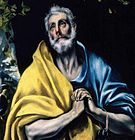Confession of Peter

| Part of a series of articles on |
| Peter in the Bible |
|---|
 |
| In the New Testament |
| Other |
In
The proclamation of Jesus as Christ is fundamental to Christology; the Confession of Peter and Jesus' acceptance of the title "Messiah" form a definitive statement in the New Testament narrative regarding the person of Jesus Christ.[4][5] In this New Testament narrative, Jesus not only accepts the titles Christ and Son of God, but declares the proclamation a divine revelation by stating that his Father in Heaven had revealed it to Peter, unequivocally declaring himself to be both Christ and the Son of God.[5]
In the same passage Jesus also selects Peter as the leader of the
The Confession of Peter is also the name of a liturgical feastday celebrated by several Christian churches, often as part of the Week of Prayer for Christian Unity.[7][8]
Gospel accounts
Narrative comparison
The following comparison table is primarily based on the New International Version (NIV) English translation of the New Testament.[9]
| Passage | Matthew | Mark | Luke |
|---|---|---|---|
| What people say | Matthew 16:13–14
|
Mark 8:27–28
|
Luke 9:18–19
|
| What the disciples say | Matthew 16:15–16
|
Mark 8:29
|
Luke 9:20
|
| Jesus selects Peter | Matthew 16:17–19
|
||
| Jesus silences the disciples | Matthew 16:20
|
Mark 8:30
|
Luke 9:21
|
Background and setting
In the New Testament, this pericope and the account of the Transfiguration of Jesus which follows it appear towards the middle of the Gospel narrative and jointly mark the beginnings of the gradual disclosure of the identity of Jesus to his disciples.[10][11]
The setting is near
Peter's Confession begins as a dialogue between Jesus and his disciples in
Earlier in the Gospel narrative, these hypotheses about Jesus' identity were provided in Mark 6:14-16 by those in the court of Herod Antipas when he wondered if Jesus was John the Baptist restored to life.[2][14]
Proclamation and acceptance
In the three Gospel accounts, after asking about the views of "the multitudes", Jesus asks his disciples about their own opinion: "But who do you say that I am?" Only Simon Peter answers him: "You are the Christ, the Son of the living God".[1][15]
Only in Matthew 16:17 Jesus blesses Peter for his answer, and later indicates this revelation is the foundational rock of the Church. This begins with:
Blessed art thou, Simon Bar-jonah: for flesh and blood hath not revealed it unto thee, but my Father who is in heaven.
In blessing Peter, Jesus not only accepts the titles
The reference to "my Father" is distinguished in that in the New Testament, Jesus never includes other individuals in such references and only refers to his Father, however when addressing the disciples he uses your Father, excluding himself from the reference.[16]
Selection of Peter
In Matthew 16:18 Jesus then continues:
And I say also unto thee, That thou art Peter, and upon this rock I will build my church; and the gates of hell shall not prevail against it. And I will give unto thee the keys of the kingdom of heaven.
The word "Peter" in this verse is, in Greek, "petros", while this "rock" is "petra". It is a play on words, but if the original language was Aramaic the word in both cases is simply "kepha". A distinction that petros meant a stone and petra a solid piece of rocky ground is sometimes suggested, but Greek use in antiquity seems to have been less precise.[17]
The word "church" (ekklesia in Greek), as used here, appears in the Gospels only once more, in
Peter's authority is further confirmed by: "Whatsoever thou shalt bind on earth shall be bound in heaven: and whatsoever thou shalt loose on earth shall be loosed in heaven." As discussed below, various Christian denominations have assigned different interpretations to the authority granted in this passage.[citation needed]
Jesus silencing the disciples
All three of the Synoptic Gospels end the account with Jesus telling the disciples not to reveal that he was the Messiah to anyone—an instance of the motif of the Messianic Secret.[citation needed]
Denominational issues
Interpretations
Various Christian denominations interpret Matthew 16:18 in different ways. Although most denominations agree that the statement applies to Peter, they diverge on their interpretations of what happens after Peter.[6]
In the
Some
The
Ecumenical meetings among different denominations have taken place regarding these interpretations, but no final agreement has emerged.[6]
Commemorations

The
The Confession of Peter is the beginning of the
See also
- Chronology of Jesus
- Denial of Peter
- Life of Jesus in the New Testament
- Transfiguration of Jesus
References
- ^ ISBN 0-664-25752-6page xvi
- ^ ISBN 0-8146-2211-9pages 885-886
- ^ Note that some translations add a few words to Luke's version, namely 'You are' and 'sent from [God]' or 'whom [God] has sent'. Similar to the other gospels, some translations render Χριστὸν as 'Anointed One' rather than 'the Christ' or 'the Messiah'. "Luke 9:20". Biblehub.com. 2011. Retrieved 8 January 2021.
- ^ ISBN 0-8028-4438-3pages 7-9
- ^ ISBN 3-11-018151-7pages 240-241
- ^ ISBN 0-664-22754-6page 69
- ISBN 978-0-8308-2707-7page 59
- ^ ISBN 1-85311-479-0Canterbury Press 2003 pages 54-55
- ^ "Online Bible – New International Version". Biblehub.com. 2011. Retrieved 8 January 2021.
- ISBN 0-8006-2337-1pages 91-95
- ISBN 0-521-00261-3pages 132-133
- ^ In Matthew's account only: Matthew 16:14
- ^ Cambridge Bible for Schools and Colleges on Matthew 16; John Lightfoot's Commentary on the Gospels on Matthew 16 and on Matthew 27, all accessed 25 January 2017
- ISBN 0-8146-5965-9page 336
- ISBN 0-664-22431-8page 109
- ISBN 0-664-24468-8pages 53-54
- ISBN 1602584133page 20
- ^ ISBN 978-0-8146-5803-1page 248
- ^ Treatise on the Power and Primacy of the Pope, paragraph 22 and following
- ISBN 978-0-89870-723-6pages 11-15
- ^ ISBN 978-0-8028-6284-6pages 35-40


